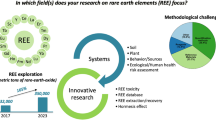Abstract
An assessment of radon concentrations at Khan Alzabib was implemented using two different approaches; the radon exhalation approach and the subsoil approach. The measurements were analyzed in view of two parameters, uranium concentration levels and the presence of fault zones. Radon measurements from the radon exhalation approach were related to the uranium concentration in the collected samples and a positive correlation was observed showing higher exhalation rates of radon for higher uranium concentration. Radon measurements from the subsoil approach showed the effect of fault zones in promoting the migration process of radon.




Similar content being viewed by others
References
van der Heyden A, Sader A, Al Dajani A, Barahmeh T (2015) Exploration trenches for uranium resource evaluation. Appl Earth Sci Trans Inst Min Metall Sect B 124:78–89
Worley Parsons Resources and Energy (2011) White paper on nuclear energy in Jordan
Alsabbagh A, Zaidan L, Harahsheh I et al (2016) Investigation of Jordanian uranium resources in carbonate rocks. J Radioanal Nucl Chem 308:1063–1070
Jönsson G (1995) Radon gas—where from and what to do? Radiat Meas 25:537–546
Al-nafiey MS, Jaafar MS, Bin Bauk S, Salih NF (2012) Design and fabrication of new radon chamber for radon calibration factor of measurement. Int J Sci Eng Res 3:1–6
Singh AK, Sengupta D, Prasad R (1999) Radon exhalation rate and uranium estimation in rock samples from Bihar uranium and copper mines using the SSNTD technique. Appl Radiat Isot 51:107–113
Mittal S, Rani A, Mehra R (2016) Radon levels in drinking water and soil samples of Jodhpur and Nagaur districts of Rajasthan, India. Appl Radiat Isot 113:53–59
Rani A, Mittal S, Mehra R, Ramola RC (2015) Assessssment of natural radionuclides in the soil samples from Marwar region of Rajasthan, India. Appl Radiat Isot 101:122–126
Ioannides K, Papachristodoulou C, Stamoulis K et al (2003) Soil gas radon: a tool for exploring active fault zones. Appl Radiat Isot 59:205–213
Kristiansson K, Malmqvist L (1982) Evidence for nondiffusive transport of 86Rn in the ground and a new physical model for the transport. Geophysics 47:1444–1452
Al-Tamimi MH, Abumurad KM (2001) Radon anomalies along faults in North of Jordan. Radiat Meas 34:397–400
Atallah M, Al-Bataina B, Mustafa H (2001) Radon emanation along the dead sea transform (rift)in Jordan. Environ Geol 40:1440–1446
King C-Y, Zhang W, King B-S (1993) Radon anomalies on three kinds of faults in California. Pure Appl Geophys 141:111–124
Fytikas M, Lombardi S, Papachristou M et al (1999) Investigation of the 1867 Lesbos (NE Aegean) earthquake fault pattern based on soil-gas geochemical data. Tectonophysics 308:249–261
Sakoda A, Hanamoto K, Ishimori Y et al (2010) First model of the effect of grain size on radon emanation. Appl Radiat Isot 68:1169–1172
Barillon R, Özgümüs A, Chambaudet A (2005) Direct recoil radon emanation from crystalline phases. Influence of moisture content. Geochim Cosmochim Acta 69:2735–2744
Semkow TM (1990) Recoil-emanation theory applied to radon release from mineral grains. Geochim Cosmochim Acta 54:425–440
Sasaki T, Gunji Y, Okuda T (2004) Mathematical modeling of radon emanation. J Nucl Sci Technol 41:142–151
Rogers VC, Nielson KK (1991) Multiphase radon generation and transport in porous materials. Health Phys 60:807–815
Sakoda A, Ishimori Y, Yamaoka K (2011) A comprehensive review of radon emanation measurements for mineral, rock, soil, mill tailing and fly ash. Appl Radiat Isot 69:1422–1435
Breitner D, Arvela H, Hellmuth KH, Renvall T (2010) Effect of moisture content on emanation at different grain size fractions—a pilot study on granitic esker sand sample. J Environ Radioact 101:1002–1006
Chitra N, Danalakshmi B, Supriya D et al (2017) Study of Radon and Thoron exhalation from soil samples of different grain sizes. Appl Radiat Isot 133:75–80
Khoury HN (2014) Importance of clay minerals in jordan case study: Volkonskoite as a sink for hazardous elements of a high pH plume. Jordan J Earth Environ Sci 6:1–10
Abzalov MZ, van der Heyden A, Saymeh A, Abuqudaira M (2015) Geology and metallogeny of Jordanian uranium deposits. Appl Earth Sci 124:63–77
Barjous M (1986) The geology of Siwaqa. Bull 4. Natural Resources Authority, Amman, Jordan
Jaser D (1986) The geology of Khan Ez Zabib. Bull 3. Natural Resources Authority, Amman, Jordan
Acknowledgements
This work was supported by the applied scientific research award offered by JOSCO and Engicon companies in Jordan. The authors wish to thank Dr. Samer Kahook (Director General of JUMCO) and Dr. Ma’mon Makahleh (Director of the Research Directorate at JAEC) for their great support throughout this work. The authors also wish to thank the entire JUMCO technical team for their support and assistance.
Author information
Authors and Affiliations
Corresponding author
Rights and permissions
About this article
Cite this article
Alsabbagh, A., Alzghoul, S., Marashdeh, S. et al. Examination of fault zones and uranium concentration effects on the in-soil radon levels at Central Jordan Area. J Radioanal Nucl Chem 317, 511–517 (2018). https://doi.org/10.1007/s10967-018-5868-3
Received:
Published:
Issue Date:
DOI: https://doi.org/10.1007/s10967-018-5868-3




